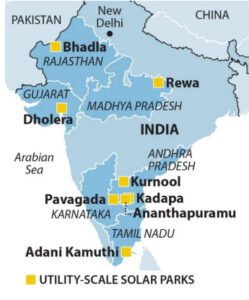The Minister of New and Renewable Energy (MNRE) R.K. Singh informed the parliament on Tuesday, regarding 50 solar parks with a combined capacity of 37,490 MW approved in 12 states and a total of 10,401 MW of solar projects sanctioned in 19 solar parks till November 30.

“The scheme under MNRE, 50 solar parks with an aggregate capacity of 37,490 MW have been sanctioned in 12 states of India, and 10,401 MW of solar projects were already sanctioned in the previous month,” said Singh.
According to the data shared by the Minister, about 12,150 MW of solar park projects in Gujarat, (8,276 MW) in Rajasthan, (4,200 MW) in Andhra Pradesh, (4,180 MW) in Madhya Pradesh, (3,730 MW) in Uttar Pradesh, (2,500 MW) in Karnataka, (1,089 MW) in Jharkhand, (750 MW) in Maharashtra, (155 MW) in Kerala, (100 MW) in Chhattisgarh and 20 MW in Mizoram were sanctioned.
Furthermore, two solar parks- Ramanathapuram Solar Park and Kadaladi Solar Park in Tamil Nadu, were sanctioned with 500 MW for each but got cancelled due to land constraints and slow progress.
When the govt started the solar park initiative, and why?

The govt of India started the ‘Development of Solar Parks and Ultra Mega Solar Power Projects’ initiative in 2014. The initiative started with the objective of boosting efficiency in the economy and sharing infrastructures like transmission lines, substations, and operation and maintenance facilities in the parks.
It also promotes India’s solar power generation capacity by avoiding the use of fossil fuels, combating climate change by reducing the emission of greenhouse gases, improving public health and much more.
Further, it provides social benefits like job creation, developing rural areas to bring economic opportunities and fostering development in solar technology to make India a global leader in the power and energy sector.
How does it benefit India?
The solar park initiative has the potential to bring a wide range of benefits like enhancing renewable energy capacity, less use of carbon, and mitigating climate change by less emission from the greenhouse.

In addition, it improves access to energy in rural or underserved areas of India for street lights, and electricity in schools and health care centres. Also, it reduces air pollution and lowers the risk of causing respiratory diseases and overall well-being.
Apart from this, this initiative will attract foreign investments to invest in India’s renewable energy sector and pave the path for a more sustainable future for the country and its people.
Anticipation of this initiative:
The initiative ignites hope for a brighter future as the anticipation for this initiative is largely optimistic toward its potential benefits for India’s energy landscape, economy, technology advancements, environment and social development.
Meanwhile, there is also the need for cautiousness regarding the challenges that need to be addressed and examined properly before going for further transformations.












Comments 1